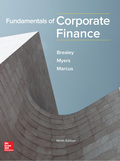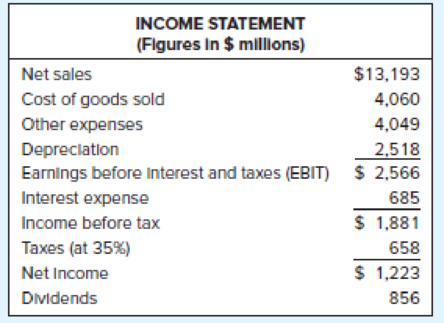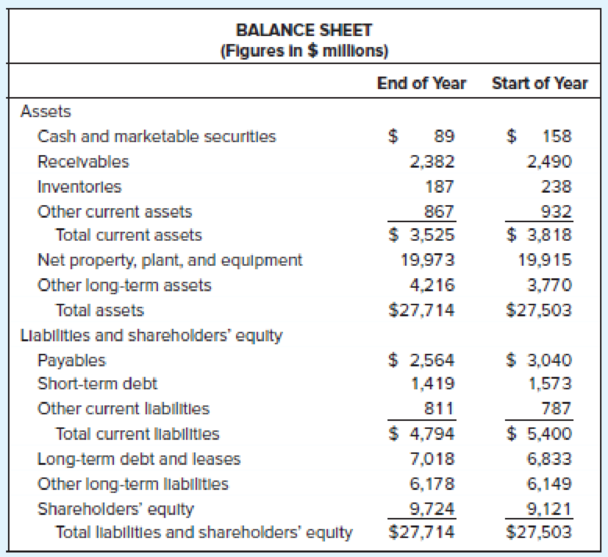
Financial Ratios. Here are simplified financial statements for Phone Corporation in a recent year:


Calculate the following financial ratios for Phone Corporation using the methodologies listed for each part:
- a.
Return on equity (use averagebalance sheet figures) - b.
Return on assets (use average balance sheet figures) - c. Return on capital (use average balance sheet figures)
- d. Days in inventory (use start-of-year balance sheet figures)
- e. Inventory turnover (use start-of-year balance sheet figures)
- f. Average collection period (use start-of-year balance sheet figures)
- g. Operating profit margin
- h. Long-term debt ratio (use end-of-year balance sheet figures)
- i. Total debt ratio (use end-of-year balance sheet figures)
- j. Times interest earned
- k. Cash coverage ratio
- l. Current ratio (use end-of-year balance sheet figures)
- m. Quick ratio (use end-of-year balance sheet figures)
a.
To compute: Return on equity (ROE)
Explanation of Solution
The formula to calculate return on equity is as follows:
The calculation of return on equity is as follows:
Hence, the ROE is 13%
b.
To compute: Return on assets (ROA)
Explanation of Solution
The formula to calculate return on asset is as follows:
The calculation of return on capital is as follows:
Hence, the ROA is 6.04%
c.
To compute: Return on capital (ROC)
Explanation of Solution
The formula to calculate return on capital is as follows:
The calculation of return on equity is as follows:
Hence, the ROC is 10.20%
d.
To compute: Days in inventory.
Explanation of Solution
The formula to calculate days in inventory is as follows:
.
The calculation of days in inventory is as follows:
Hence, the days in inventory is 21.40 days
e.
To compute: Inventory turn over
Explanation of Solution
The formula to calculate inventory turnover is as follows:
The calculation of inventory turnover is as follows:
Hence, the inventory turnover is 19.11
f.
To compute: Average collection period(ACP)
Explanation of Solution
The formula to calculate average collection period is as follows:
The calculation of average collection period is as follows:
Hence, the ACP is 68.89 days.
g.
To compute: Operating profit margin (OPM)
Explanation of Solution
The formula to calculate operating profit margin is as follows:
The calculation of operating profit margin is as follows:
Hence, the OPM is 12.64%
h.
To compute: Long term debt ratio
Explanation of Solution
The formula to calculate operating profit margin is as follows:
The calculation of long term debt ratio is as follows:
Hence the long term debt ratio is 0.42
i.
To compute: Total debt ratio
Explanation of Solution
The formula to calculate total debt ratio is as follows:
The calculation of total debt ratio is as follows:
Hence the total debt ratio is 0.65
j.
To compute: Times interest earned
Explanation of Solution
The formula to calculate times interest earned is as follows:
The calculation of times interest earned is as follows:
Hence the time interest earned is 3.75
k.
To compute: Cash coverage ratio
Explanation of Solution
The formula to calculate cash coverage ratio is as follows:
The calculation of cash coverage ratio is as follows:
Hence the cash coverage ratio is 7.42
l.
To compute: Current ratio
Explanation of Solution
The formula to calculate current ratio is as follows:
The calculation of current ratio is as follows:
Hence the current ratio is 0.74
m.
To compute: Quick ratio
Explanation of Solution
The formula to calculate quick ratio is as follows:
The calculation of quick ratio is as follows:
Hence the quick ratio is 0.52
Want to see more full solutions like this?
Chapter 4 Solutions
EBK FUNDAMENTALS OF CORPORATE FINANCE
- If data is unclear or blurr then comment i will write it. please don't use AI i will unhelpfularrow_forwardYou are considering an option to purchase or rent a single residential property. You can rent it for $5,000 per month and the owner would be responsible for maintenance, property insurance, and property taxes. Alternatively, you can purchase this property for $204,500 and finance it with an 80 percent mortgage loan at 4 percent interest that will fully amortize over a 30-year period. The loan can be prepaid at any time with no penalty. You have done research in the market area and found that (1) properties have historically appreciated at an annual rate of 2 percent per year, and rents on similar properties have also increased at 2 percent annually; (2) maintenance and insurance are currently $1,545.00 each per year and they have been increasing at a rate of 3 percent per year; (3) you are in a 24 percent marginal tax rate and plan to occupy the property as your principal residence for at least four years; (4) the capital gains exclusion would apply when you sell the property; (5)…arrow_forwardIf data is unclear or blurr then comment i will write it.arrow_forward
- I need answer typing clear urjent no chatgpt used pls i will give 5 Upvotes.arrow_forwardcorrect an If image is blurr or data is unclear then plz comment i will write values or upload a new image. i will give unhelpful if you will use incorrect data.arrow_forwardWhat are the five management assertions that serve as basis for financial statements audit programs?arrow_forward
- PROBLEM 2 On July 1, 2022, LTU Contracting, Inc. purchased a new Peiner SK575 Tower Crane for a total cost of $875,000. The crane has an estimated useful life of five (5) years. For financial reporting (book) purposes, the company utilizes straight line depreciation. For tax purposes, the equipment is depreciated over five years utilizing the 200% declining balance method. A. Prepare a table that computes the book and tax depreciation for each year of the useful life and determine the difference in book value between each method at the end of each year. B. On July 1st, 2025, the company is considering selling the crane for $500,000. Compute what the gain or loss would have been at that time for both book and tax purposes.arrow_forwardBrightwoodę Furniture provides the following financial data for a given enod: Sales Aount ($) Per Unit ($) 150,000 13 Less Variable E - L96,000 13 Contribwaon Margin c 1C Less Fixed Expenses $5,000 et Income 125,000 a. What is the company's CM ratio? b. If quarterly sales increase by $5,200 and there is no change in fixed expenses, by how much would you expect quarterly net operating income to increase?arrow_forwardPlease give correct answer dont use chatgpt . if image is blurr or any data is unclear then please comment i will write values , dont give answer without sure that data in image is showing properly.arrow_forward
 Managerial AccountingAccountingISBN:9781337912020Author:Carl Warren, Ph.d. Cma William B. TaylerPublisher:South-Western College Pub
Managerial AccountingAccountingISBN:9781337912020Author:Carl Warren, Ph.d. Cma William B. TaylerPublisher:South-Western College Pub Managerial Accounting: The Cornerstone of Busines...AccountingISBN:9781337115773Author:Maryanne M. Mowen, Don R. Hansen, Dan L. HeitgerPublisher:Cengage Learning
Managerial Accounting: The Cornerstone of Busines...AccountingISBN:9781337115773Author:Maryanne M. Mowen, Don R. Hansen, Dan L. HeitgerPublisher:Cengage Learning Cornerstones of Financial AccountingAccountingISBN:9781337690881Author:Jay Rich, Jeff JonesPublisher:Cengage Learning
Cornerstones of Financial AccountingAccountingISBN:9781337690881Author:Jay Rich, Jeff JonesPublisher:Cengage Learning Financial AccountingAccountingISBN:9781337272124Author:Carl Warren, James M. Reeve, Jonathan DuchacPublisher:Cengage Learning
Financial AccountingAccountingISBN:9781337272124Author:Carl Warren, James M. Reeve, Jonathan DuchacPublisher:Cengage Learning Financial And Managerial AccountingAccountingISBN:9781337902663Author:WARREN, Carl S.Publisher:Cengage Learning,
Financial And Managerial AccountingAccountingISBN:9781337902663Author:WARREN, Carl S.Publisher:Cengage Learning,





